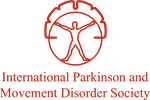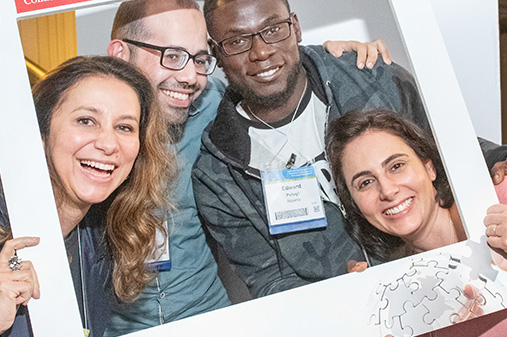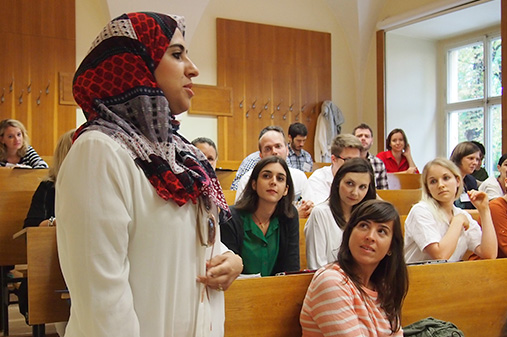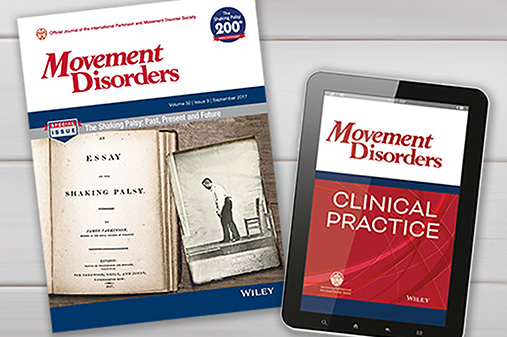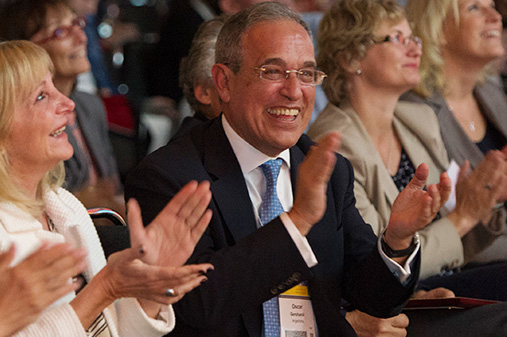Tremor Series: The novel pharmacological and surgical treatments for tremor
[00:00:04] Dr. Alfonso Fasano: Hello everyone, and welcome to the MDS podcast, the official podcast of the International Parkinson's and Motor Disorders Society. I'm Alfonso Fasano, professor of neurology and clinical investigator at the University of Toronto in Canada, and I'm the guest editor for this new special series on tremor.
Today I'm interviewing Ludy Shih from the Beth Israel Deaconess Medical Center in Boston, and the topic of today's podcast will be the novel pharmacological and surgical treatments of tremor. Thank you, Ludy, for being with us.
View complete transcript
[00:00:38] Dr. Ludy Shih: Thank you for having me, Alfonso. Pleasure to be here.
[00:00:41] Dr. Alfonso Fasano: It's our pleasure, and let's get started because we have a lot to cover, as you know well. So my first question to you would be in absence of, treatments, at least no lack of new approved pharmacological treatments. What drugs are you currently using in your day to day practice?
[00:00:58] Dr. Ludy Shih: Yeah, essentially we're [00:01:00] here many decades later after having had the first two medications for tremor, essential tremor, specifically propranolol and primidone, and many of us are still using those in the clinic. So I will still typically use those as first line agents. As we have some evidence guidelines created by various academies and societies.
Movement Disorder Society also has one in addition to the American Academy of Neurology. And a lot of the drugs that we know have been tried have not been conclusively shown to be effective. So propranolol, primidone, and topiramate have the best evidence. And depending on the side effect profile, we'll choose among these for the individual patients.
[00:01:41] Dr. Alfonso Fasano: Okay. Thank you. And this, by the way, mirrors my experience too. But we also see in this many review papers that there are another long list of additional drugs that people from time to time might use, even though the evidence is less robust. Let's say you have a patient that failed the highest tolerated dose of these [00:02:00] drugs.
often combined as we do often is there any other drug that you will go to even though the evidence maybe is not so strong?
[00:02:07] Dr. Ludy Shih: Sure. I think that one of the challenges we have is there are many medications for which we can get at the mechanism of tremor, especially if it's you can talk with the patient and get a sense that maybe anxiety really provokes their tremor. And that's true for a lot of people.
And you may then want to start to think about things that are somewhat anxiolytic, like gabapentin, or in some cases benzodiazepines. Other times, the beta blocker is preferred, but somehow they're intolerant of side effects, and so some people have switched to some of the other beta blockers, like metoprolol or nadolol, for example.
And then I would say, lastly there have been some attempts to use zonisamide because it is similar in some ways to tapiramate but I don't know that the evidence there nor my anecdotal experience in clinic [00:03:00] has been all that good with that medication either. It's is a real quandary as to what else we can really use in the clinic for these patients.
[00:03:09] Dr. Alfonso Fasano: Yeah, absolutely. I agree with you. And actually your answer also emphasizes the a common misconception. I'm sure you agree that any beta blocker will do the job. I often see patients that are put on, you the mildest beta blocker for tremor. But in reality, you wanna be using a lipophilic drug that crosses the BBB with a wide spectrum of beta one and beta two.
And really that's only propanol. The other ones, unless you're dealing with peripherally induced tremor. That don't really make a difference in my experience. And in fact, some can also. Be theoretically associated with a worsening for example pindolol and also others beta blocker with an intrinsic symmatic activity that can make tremor worse.
So I think it's important for the listeners to, to appreciate that not every beta blocker is gonna do the job, and if possible, propranolol will [00:04:00] be the one.
[00:04:01] Dr. Ludy Shih: I think you raise an interesting point though, which is the common difficulty we have distinguishing an enhanced physiologic tremor from essential tremor. And I think this probably happens quite commonly in the clinic. And it could be that propranolol may be more effective for these high frequency, very low amplitude tremors.
And as the tremor gets more severe, and this is part of the conversation we have with the patient, we have to be quite open with them. A very large amplitude tremor will likely not even respond to any of the oral medications we've been talking about.
[00:04:32] Dr. Alfonso Fasano: Absolutely. And this is why. There are surgical options and some people go straight to surgical options. We'll talk about it in a second, but before we go there a lot has been happening in the space, in the landscape of therapeutics for tremor. And that's finally happening. I've been doing this for a long enough to say that this is an absolute revolution because for years, companies had no interest in producing drugs specifically for tremor.
Probably now they're realizing there is, that there is [00:05:00] market tremor is a very common condition. And especially in the States, there are many companies working on it. New compounds. So can you guys us through the newest pharmacological options that are under experimentation right this moment?
[00:05:14] Dr. Ludy Shih: Yeah. So we've actually had three, at least three companies that have been really active in this space. And a few of them just came out with their results earlier this year. And one of them is still in clinical trials. One of them is brought forth by a company called Cavion, and it was a T type calcium channel blocker.
And calcium channel blockers are rather interesting because we know they are highly expressed in the neurons that serve the thalamocortical network in the brain. And there was a lot of excitement over some of the early pharmacodynamic and biomarker studies in these cases. But there I've already seen that medication doesn't seem to have panned [00:06:00] out.
That was sold to a company named Jazz Pharmaceuticals. And then Sage Pharmaceuticals was working on a very interesting compound, which basically is a GABA modulator. And positive allosteric modulator of GABA. And this one also just read out this past summer. And unfortunately, in a large phase two trial, it didn't change the primary endpoint of the TETRAS performance scale on essential tremor.
And then this last one is interesting. It's brought forward by a company called Praxis Precision Medicines and they've called it elixocaltamide and it's also another calcium channel blocker. And this one was introduced in an early phase two study where there seemed to be some worsening of tremor upon withdrawal of the drug.
So the overall evidence was borderline, but The sponsor decided to take it forward into larger phase three trials. And that is currently ongoing in [00:07:00] a unique fashion. It's being done fully remotely so called decentralized clinical trials. So that one, we don't know the results yet but I'm afraid the other two haven't shown efficacy enough to bring it forward.
[00:07:13] Dr. Alfonso Fasano: Yes, I think. Thank you. Thanks for the overview. And I found particularly fascinating this decentralized approach to a clinical trial where patients can. directly be in touch with the PI and see whether they can be enrolled for a clinical trial. And that's clearly is changing a little bit the way we run clinical trials, which is doable for a condition like tremor that is so frequent.
I will also argue that many of these patients have a wrong diagnosis of essential tremor. And maybe we need to clarify that all these companies are investing in essential tremor. As it is defined right now by the current guidelines in another episode of this podcast, I'll discuss actually with the writer of the guidelines the problems associated with the diagnostic [00:08:00] criteria currently in use for essential tremor.
And I won't go into the issue of soft signs, essential tremor plus, but I think, and I want to take your opinion on that. I think regardless of the efficacy or not shown in this trial. It will be interesting to see whether these treatments, these new approaches will be particularly beneficial in a subset of patients, given the heterogeneity of the condition or combined with other treatment.
For example, I know that some of these companies have been looking back at their data and see whether there is a synergistic effect with propanolol. So I don't know. What do you think about that? what the next steps might be for these options.
[00:08:42] Dr. Ludy Shih: Yeah, so as far as I know, from all these trials, I think they did take care to try to as you said, verify the eligibility, verify the diagnosis. And it is interesting. And we've known now for a number of years that essential tremor diagnoses are actually deceptively simple to make. We do have [00:09:00] high rates of misdiagnosis of essential tremor.
So that's one thing is careful adjudication into all these studies that will continue as a trend. And I think a severity level inclusion criteria also helps. And I think we've seen that from the sponsors, and I think we'll still see continued emphasis on this. And I think that's probably wise. Combination therapies are, I think, are very interesting.
And I think useful to look at, I think one challenge in a sponsor, bringing forward studies like that, and also. interpreting results and adverse events is that they now have two drugs that they need to put forward in front of the regulatory agency and only Propranolol is the only one that's actually been approved by the U. S. Food and Drug Administration. So I think there's going to be continued enthusiasm in this field because the trials are very feasible to do. We have great endpoints. We have a very motivated patient population for whom we have not. really come up with anything super successful in the oral medication realm for many [00:10:00] decades now.
[00:10:00] Dr. Alfonso Fasano: Yeah, absolutely. And I agree with you, it will be difficult to do trials with multiple compounds at the same time. But as we always see some of the the ways we shape our treatment protocols is based on clinical experience on the post commercialization path of these drugs, if they make it to the market.
Let's switch to Another topic before we deal with surgical options, I just have a question about botulinum toxin. Do you use it in your clinical practice for tremor treatment?
[00:10:31] Dr. Ludy Shih: Yeah, I haven't yet. I would be interested, although, I think some of the data that's coming out shows us why some of us are hesitant to use it, although I think there are some promising efforts to try to make it more local, more specific. I think the thing that I'm alluding to is that in the muscles of the hand, for example, where you need to apply the botulinum toxin these can be associated with weakness and our hand and finger muscles are some of the most commonly use body [00:11:00] parts that we use each day. And I think some focused efforts by bajaj, I think that. That is bringing forward botulinum toxin therapies to try an essential tremor. I think it'll be interesting to see what things like ultrasound and things to improve the localization and the customization of the Botox doses might do to potentially bring for that.
So I would like to see that data before going further. How about you?
[00:11:28] Dr. Alfonso Fasano: Yeah, I agree with you. Yeah, I think exactly the same thing you said. And I would add to that, that also given Recent publications, there's a trial published in the New England Journal of Medicine that it depends also on the location of the tremor. We know that head tremor, especially when it's a no tremor that you may see mainly in dystonia, that might respond fairly well to botulinum toxin because it's an easier muscle or pattern.
It's not the complicated forearm anatomy. And even if you have some weakness, you don't want to cause neck weakness, but a little bit of weakness won't translate into a [00:12:00] functional impairment to the same extent you will see with weakness in the hand. So when I use it is usually for this type of tremor or for proximal tremor when I inject the pectoralis muscles, the deltoid.
But in this case, we end up in a, in an off label environment with other problems that obviously need to be acknowledged in terms of informed consent, coverage. So it is complicated. But I didn't want to skip the topic of botulinum toxin in case the listeners were interested in hearing.
Anything else before we move on?
[00:12:31] Dr. Ludy Shih: No, I agree. I think that the head tremor can be very effectively treated and often these patients have concomitant cervical dystonia. So I think this is worth pursuing
[00:12:42] Dr. Alfonso Fasano: And then there's the other problem of how to label these patients because is that dystonia tremor? Some people argue, that's tremor and dystonia. Some people say it's essential tremor with cervical dystonia, which doesn't make too much sense. So anyways, but that's topic for another episode of this podcast.
Let's move on to [00:13:00] surgery now. So can can you tell us your thoughts about surgery, not just the established one, but also what's new and what's adopted more and more on a daily basis?
[00:13:08] Dr. Ludy Shih: So, I think people know deep brain stimulation for tremor was at least approved in the US by the food and drug administration in 1997. So it's been with us a long time and sometimes patients are surprised to hear that. And when physicians talk. To them about this therapy, they can bring that forward.
So we now have many years of experience. And of course there was a lot of experience before that. This was just the approval of of the therapy. as people know it's very highly effective. It is associated with rates of close to 90% improvement in tremor. I think this really, of course, depends on the baseline tremor, amplitude, and we've reviewed a lot of case series.
And as well as the pivotal trials in this space, I think, because now it's been with us for so long, some of us have started to see that with time patients can say that the DBS doesn't work quite as well as it used [00:14:00] to when it first was initiated. And this has been a real conundrum in the field.
Is this a. lack of efficacy of the DBS itself. Is there something about the substrate of the neurons and the axons? It's stimulating and it's not having the same effect as it used to, or is it part of the disease progression? And this is really just essential tremor, which I think is another mystery that we need to solve.
Why does tremor progress in this way? And why do people continue to get worse? what look more and more like cerebellar features like intention tremor and sometimes stimulation induced ataxia for when clinicians are trying earnestly to try to make the patient happy, control their tremor, but inadvertently overstimulate and produce some additional problems.
So I think these have been addressed by a number of groups over the years. We had certainly been interested in just, understanding the natural history of it. How common is this? And then I think people got interested and started thinking maybe it's the location of the electrode. [00:15:00] And Andy Horn and the group of And Andrea Kuhn in Germany have also done some really nice work looking at the location and the sweet spot where this may happen to be the best place to stimulate for these kinds of more severe tremors , Gunter Deuschl and company have also surmise that there are aspects that are very inferior To the thalamus, perhaps in the zone and posterior subthalamic area that might be better for this, but we really don't know.
I think that's just the problem in the DBS world is it's hard to do head to head trials in a very rigorous fashion and to do them long term to compare long term outcomes. I think we have more work to do there. I think people have started exploring even other targets for very difficult to treat tremors.
We all have patients like this. may not even be essential tremor, but other post stroke tremors or multiple sclerosis associated tremor for which ataxia may be a common feature.
[00:15:54] Dr. Alfonso Fasano: Yeah, I agree. I agree entirely. And it's really an open [00:16:00] question. And we've been trying to as a movement disorder society, we are trying to answer this question, collecting data altogether. So do you use focus ultrasound on a regular basis? How do you prescribe these options?
[00:16:12] Dr. Ludy Shih: Yeah, so the other, as you say, the other surgical option is focused ultrasound thalamotomy, which have gained a lot of interest. That was approved, I believe, 2017 in the US and currently approved for unilateral side. So 1 sided, so conversation with the patient is okay. Do you care about. One hand or both hands, is it sufficient to have just the dominant hand factoring in, in two other things, there are a lot of, I think, patients that I think you wrote about this really came out of the woodwork so to say, when the thalamotomy was approved and they said, Hey, I want this.
I've never seen a doctor for my essential tremor and I've been living with it for decades. And that's the experience we all have, is that a lot of patients live much, much of their lives away from the [00:17:00] clinic, not even having come to see the doctor about, or a neurologist about their essential tremor, but this really got people's attention.
There's no hardware. It's really viewed as non-invasive, which there's no scalp incision or. burr hole drilling in the skull. But, still people need to sit in a frame, sit in an MRI, very still need to have their head shaved, and there needs to be a skull density ratio, a skull thickness that is favorable to even performing this procedure both effectively and as I understand it, the patient.
The pain factor is an issue if the skull density is too much and I do talk about it with every patient. We have one here in Boston and we talk about, their goals for therapy. And if it's really to not have to deal with hardware to really be happy with one side. Now, of course, there's data emerging on whether it's safe to do bilateral focused ultrasound thalamotomy.
There was recently a JAMA neurology article that just came out from the group in West Virginia. Showing some pretty good outcomes in a [00:18:00] bilateral staged approach. But it was open label and there was still some adverse effects that were there much of which, as we know from a focused ultrasound thalamotomy, there will be some side effects like dysarthria or gait disorder.
that tend to be worst in the first few months and may subside. But sometimes for some people, not completely.
[00:18:20] Dr. Alfonso Fasano: Yep. and so I think in terms of bilateral at the moment, the FDA is approving also the bilateral thalamotomy, as long as it's done with, I think, a delay it's a staged procedure with at least nine months in between. No, I'm not practicing in the States, but I think this is where the FDA is at the moment.
But when patients ask you about the Focus ultrasound, how do you phrase it? Because the biggest misconception is that's not surgery. So people will come to you and say, no, I don't want surgery. I want focused ultrasound. How do you phrase it to them?
[00:18:54] Dr. Ludy Shih: I, it's interesting. I think we must all have different styles. I actually say they're really both surgical [00:19:00] procedures. One is just done without an incision and without a burr hole. But I do talk them through the process of how in deep brain stimulation, an electrode is placed in the area of interest, whereas in focused ultrasound some very high energy ultrasound waves are directed at a portion of the brain to heat them up to the extent that some of it actually dies a little bit, and I use a little bit so that I emphasize that it is a small area, but we have to be pretty open about the fact that's really the intent of the procedure is to really ablate those neurons.
[00:19:33] Dr. Alfonso Fasano: Yeah, I agree entirely with you. That has to be clarified from the get go. Last comment or question it has to do with a part of the. management of tremor that is not really well covered in reviews or during meetings, which is all the other tools that patients might use for spoon cups or stimulating the periphery.
What's your take on these options?
[00:19:57] Dr. Ludy Shih: Yeah. It's interesting. Patients will [00:20:00] take whatever help they can get, and so a weighted utensil or a spoon and this is just simply a utensil with a heavier weight. But there have been attempts over the years to. include gyroscopes or other motors in these devices to try to so called cancel out the tremor as if they oscillate at a frequency that then cancels out the person's frequency that they exhibit in the hand that might make eating a little bit easier.
So those to my knowledge have not been quite as popular as the simple weighted utensil that many people can get. Often occupational therapists have show patients a catalog and I think you can get that. these on amazon. com in your country or not in your country and shipped to you from elsewhere. And they're quite popular that way.
However, I think people are still looking for devices to actually improve their tremor even when they're not using that particular diaphragm. device. And so comes this idea that this company in California came up [00:21:00] with, called Kayla Health. It's the transcutanein afferent afferent pattern stimulation, which is basically to say it's a electrical stimulation of the nerves in the wrist, usually the median and radial nerves.
And applying this by wearing a wrist worn device and having it stimulate those nerves for about 40 minutes. People might experience a small tremor benefit for about 30 to 90 minutes after they apply this. And so for people who really have not done well with oral medications yet, aren't really prepared to go to brain surgery.
And let's be there are a lot of people in the world who have just decided they will never do brain surgery for their tremor. This is an interesting option for them. Now, up until recently, it was not paid for by our health insurance companies or Medicare, which is the plan that many people over age 65 in the U. S. are covered by. But that recently changed when the company tried to provide more evidence of clinical [00:22:00] efficacy. But I think there's opportunity here because I think the tremor benefit is quite small. With that device, and I'm not sure how that will be explored further and in studies by the company.
But I think you will start to see other companies who are trying to improve upon that idea and explore the use of wearables to not just monitor tremor, but actually treat it. I think we'll see some more of that coming up.
[00:22:27] Dr. Alfonso Fasano: Yeah, absolutely. And for sure, there's a lot more to come. And for example, talking about Calatrio, what's interesting is that the response is very variable. There are some people that are prolonged response after using it. Some people that start benefit from the device while they're wearing it very soon.
So really again, it speaks to this heterogeneity that we call essential tremor or in general tremor as a chapter in another episode of this podcast we discussed the concept of tremor as a very common, but also very difficult entity in clinical [00:23:00] neurology. Anyways, I really want to thank you, Ludy, for taking the time today to guide us through this very complex landscape that is the treatment of tremor, especially looking at the future.
And the good news is that there is so much going on that patients will have for sure new options in the upcoming years. So thank you all for listening. My name is Alfonso Fasano from Toronto. You just listened to this episode of the podcast of the MDS on tremor. The title of this podcast today was the novel pharmacological surgical treatment of tremor.
Our guest was Dr. Ludy Shih from the Beth Israel Victimness Medical Center in Boston. Thank you all. Thank you, Ludy.
[00:23:38] Dr. Ludy Shih: Thank you for having me.
[00:24:00]

Ludy C. Shih, MD, MMSc
Beth Israel Deaconess Medical Center
Harvard Medical School
Boston, USA
